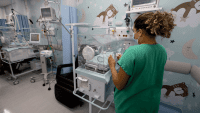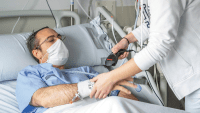Typically, nursing research is overseen by nurses with advanced degrees who work in academic settings. Nurses at nonacademic hospitals have less exposure to nursing research, so when these hospitals seek Magnet™ designation, they may have difficulty meeting the nursing research expectations of the American Nurses Credentialing Center (ANCC).
This was the situation facing Robert Packer Hospital, a rural, 238-bed, tertiary-care nonacademic teaching facility in Sayre, Pennsylvania. As it began its Magnet journey, only about one-third of its staff nurses had bachelor’s degrees. The remainder held associate degrees or nursing diplomas and had little experience with nursing research and evidence-based practice (EBP). To engage the staff in these endeavors, nursing leaders at the hospital created a Nursing Research Council (NRC).
Problem statement: Limited experience with research and EBP
The nursing profession expands its knowledge base through research, which in turn drives nursing theory, substantiates what nurses do, and guides nurses’ decision making. To demonstrate nursing excellence and establish credibility among healthcare professionals, nurses must pursue new knowledge and apply it to their practice so they can provide high-quality care. The ANCC Accreditation Program Application Manual states that “Magnet organizations conscientiously integrate evidence-based practice and research into clinical and operational processes. Nurses [should be] educated about evidence-based practice and research, [which] enables them to appropriately explore the safest and best practices for their patients and practice environments, and to generate new knowledge.”
Believing the nursing staff had many characteristics of Magnet nurses, Robert Packer’s nursing leaders quickly identified the opportunity for nurses to get more involved in EBP and nursing research. But they knew that less than half had received adequate exposure to the nursing research process and that overall, staff nurses rarely used evidence to change potentially harmful, outdated, or ineffective practices. They realized the staff would require education in these areas before they could become engaged in research and EBP. However, the facility lacked a doctorally prepared nurse to address these issues.
Solution: Partner with nursing school faculty
To overcome this hurdle, nursing leaders decided to partner with the nursing school of a local private college to tap into the expertise of its doctorally prepared program director. Establishing an NRC also was crucial in creating a culture that valued research. The NRC consisted of 10 staff nurses and five master’s-prepared clinical nurse educators. Its two mentors were nonvoting council members. One was the doctorally prepared program director from the local college; the other was one of the master’s-prepared clinical nurse educators.
The mentors collaborated with the NRC’s elected chairperson (who was a staff nurse and graduate student) to provide it with foundational education about nursing research and EBP concepts. To extend itself to the rest of the nursing staff and create excitement about nursing research and EBP, the NRC planned educational sessions for nurses, poster presentations, policy updating, and journal article critiques. But before these events could take place, NRC members realized they needed to get firsthand experience with the research process so they could more effectively engage the nursing staff.
Literature review
After deliberating over the best way to gain experience with nursing research and engage coworkers in the process, the NRC decided to conduct a literature review to find articles describing unique methods of teaching nursing research. They found three articles; two focused on educating nursing students, the third on educating nursing staff. All three concluded that participating in the nursing research process is a valuable learning tool. (See Teaching nurses about research: Key articles by clicking on the pdf icon above.)
Methodology
Using an active learning strategy is one of the best ways to learn and retain knowledge. Initially, this strategy was developed to teach nursing students.
As a model for this nursing research project, the NRC chose an active learning strategy described by Theil in 1987, in which learners participated in planning a mock study (including study design), the informed consent process, and the collection, analysis, and evaluation of data to compare two different chocolate-chip cookie recipes. After obtaining informed consent from mock study participants, the learners conducted a cookie taste test and elicited tasters’ opinions. From their data analysis, they drew conclusions about the tasters’ cookie preferences. This simulated research was an effective firsthand experience that helped nursing students learn the nursing research process.
For its own nursing research, the NRC chose to adapt the Theil project, replacing chocolate-chip cookies with peanut butter. It wrote a study protocol and developed a study consent form and data collection tools. The protocol required NRC members to conduct a peanut-butter taste test, concealing the identity of two different peanut butter brands and offering samples to interested hospital staff. NRC members took the role of nurse researchers, coworkers served as study participants, and NRC mentors oversaw project development.
To round out the nursing research process, the project was submitted for presentation to professional nursing audiences. It was selected by peer review as a podium presentation at two nursing conferences, one regional and the other national. As NRC members presented their research, they focused on the innovative style and advantages of the educational strategy.
Plaudits for the “Peanutty” project
Dubbed the “Peanutty over nursing research” project, this study generated much excitement and pride among NRC members. It enabled them to articulate the steps of the nursing research process and serve as unit resources to peers. Eager to share what they’d learned, they assembled posters that defined basic research terms and applied them to the study to illustrate the basic steps of the research process. They presented the posters at unit staff meetings and displayed them on nursing units.
NRC members believe this hands-on approach made nursing research real to bedside nurses at Robert Packer Hospital. Firsthand experience with this process helped the nurses better understand published nursing research and their role in conducting such research or collecting research data for other nurses, and increased their appreciation of EBP in the clinical practice setting.
By educating coworkers and sharing their work at the local and national levels, NRC members completed the nursing research process, illustrating the importance of disseminating nursing research outcomes to the larger nursing community. By the time of the hospital’s Magnet site survey, staff nurses were actively engaged in several EBP and nursing research activities and were able to show ANCC reviewers they were indeed Magnet-caliber nurses.
Selected references
Visit www.AmericanNurseToday.com/Archives.aspx for a complete list of selected references.
Sally Bennett and Mary Hicks are Clinical Nurse Educators and Debra Raupers is the Magnet Coordinator and Director of Nursing Education and Research at Robert Packer Hospital in Sayre, Pennsylvania. Lois Schoener is Director of the Nurse Education Program at Elmira College in Elmira, New York. The authors wish to acknowledge the members of the Nursing Research Council at Robert Packer Hospital, as well as Dr. Robert Bienkowski, PhD, Director of Research and Clinical Innovation at Guthrie Healthcare System, for their support and assistance with this project.

















